This content originally appeared on Radio Free Europe/Radio Liberty and was authored by Radio Free Europe/Radio Liberty.
This post was originally published on Radio Free.
This content originally appeared on Radio Free Europe/Radio Liberty and was authored by Radio Free Europe/Radio Liberty.
This post was originally published on Radio Free.
Read a version of this story in Korean
North Korea is posthumously granting membership in the Korean Workers’ Party to its soldiers killed in action in Russia’s war with Ukraine — a perk that will benefit their surviving families, residents in the country told Radio Free Asia.
Party membership is a special privilege in North Korea that improves the social status of families related to the member, giving them access to better education, jobs, housing and food rations.
It may also give them the right to live in the capital Pyongyang, which has a far better standard of living than the rest of the country.
But some parents who are notified that their sons have died in battle did not even know they had been sent to Russia, a resident in the northeastern province of North Hamgyong told RFA Korean on condition of anonymity for security reasons.
The Pentagon and South Korean intelligence estimate that around 12,000 North Korean troops have been deployed to Russia since October. According to South Korean intelligence, at least 300 of these have been killed and 2,700 injured.
Neither Moscow nor Pyongyang has acknowledged North Korea’s participation in the conflict.
The North Korean people have not been informed, either, but many seem to have heard about it through word of mouth, the resident said.
“In early January, a couple living in Myonggan county, relatives of my close friend, were told to go to Pyongyang without knowing the reason,” the resident said.
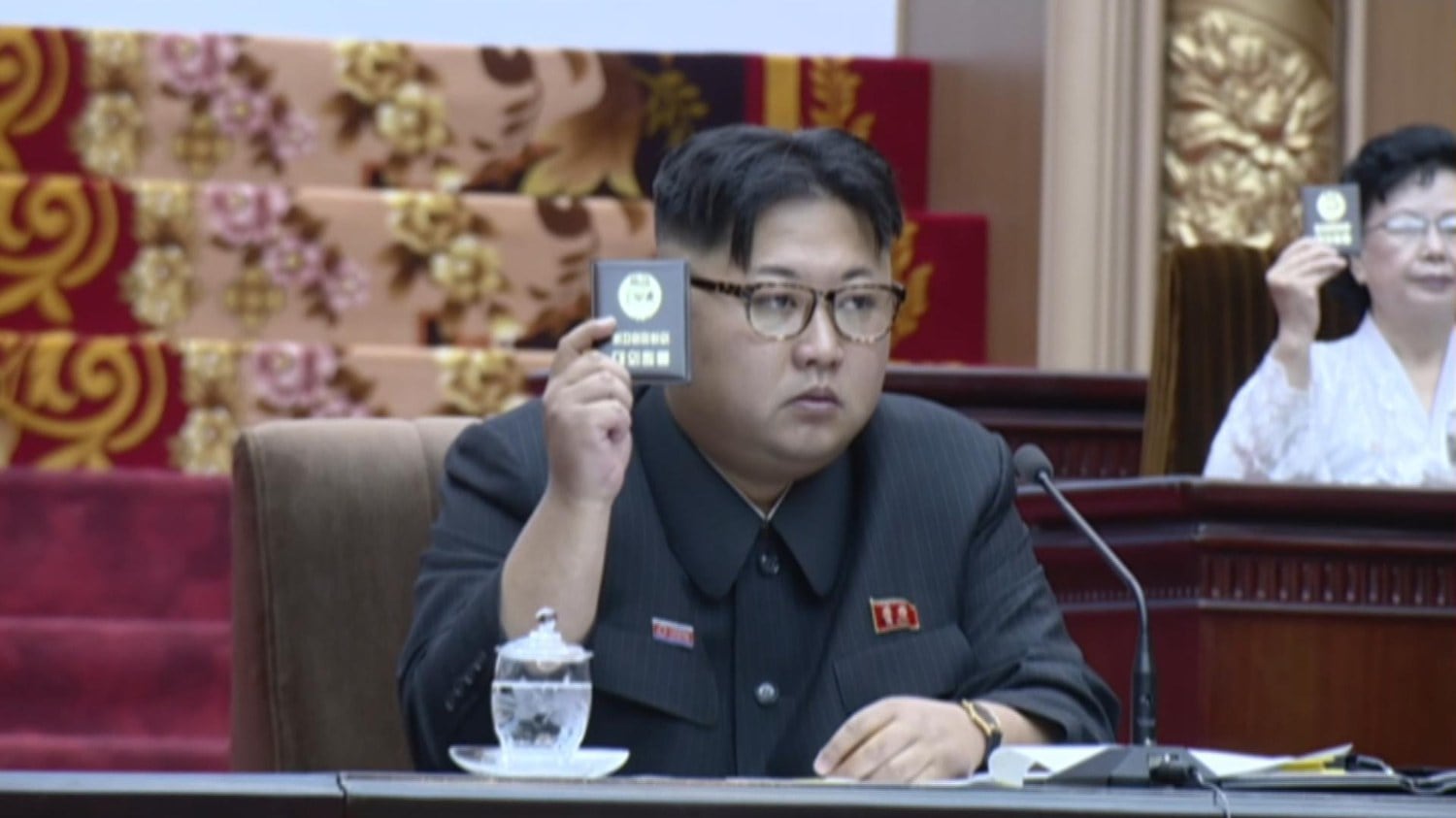
A senior local official — the county secretary — took them to the station in his car and and provided train tickets and lunch boxes to eat on the train — a rarity in North Korea, where most people cannot freely travel, especially not at government expense.
Once in Pyongyang, the couple was given a certificate informing them of their son’s death and a party membership card — but were told nothing about the nature of his mission or where he died, the resident said.
Authorities urged them to keep quiet.
“They did not even allow the bereaved families to cry out loud,” he said. “They repeatedly urged them not to share information with other relatives or anyone around them.”
Upon their return, the special treatment for the couple continued.
The county secretary picked them up and delivered them to their home, and ordered the factory where the man works to give him a special 10-day vacation, the resident said.
But even though the family is already getting the perks, they would rather have their son alive, he said.
RELATED STORIES
Ukraine recovers combat instructional documents from killed North Korean soldier
North Korean military raises enlistment age limit from 23 to 25
North Korean soldier captured by Ukraine says he ‘didn’t know’ who he was fighting
“According to my friend, his relative believes his son was killed while deployed to fight in the war with Ukraine,” he said. “The couple spends each day in tears, mourning the loss of their only son.”
Posthumous membership in the party is usually only given in combat situations, not to soldiers who die while performing their usual peacetime duties.
Another resident of the same province said that the authorities have promised to allow the family members of the soldiers killed in the war with Ukraine to live in Pyongyang as soon as there are available homes for them.
Since 2021, the country’s leader Kim Jong Un has been pushing his pet development project — to build 10,000 homes per year and 50,000 by the end of 2025 — in the capital.
According to the second resident, his wife’s relatives traveled to Pyongyang and received their dead son’s party membership card and death certificate at a ceremony where an official informed them that they would be able to live in the new homes.
“The party has decided that when Hwasong Street, which is currently under construction, is completed, the bereaved families will be called to Pyongyang and live there as Pyongyang citizens,” he said.
In previous reports about the housing project, Pyongyang residents told RFA that their homes were being demolished to build the new apartments. Although they were promised the right to live there once the homes were completed, they were concerned that there would not be enough new apartments to accommodate everyone.
The second resident said that the authorities asked all the bereaved families to not reveal too much information to the outside world, regarding why they are allowed to move to Pyongyang.
“Among the family members from my wife’s side, there are some who envy the relatives who will be living in Pyongyang in the future,” he said. “But the parents who lost their son are expressing their anger, saying, ‘What good is it when we lost our son? He was only 21 years old.”
Translated by Claire S. Lee. Edited by Eugene Whong and Malcolm Foster.
This content originally appeared on Radio Free Asia and was authored by Ahn Chang Gyu for RFA Korean.
This post was originally published on Radio Free.
This content originally appeared on Radio Free Europe/Radio Liberty and was authored by Radio Free Europe/Radio Liberty.
This post was originally published on Radio Free.
This content originally appeared on Radio Free Europe/Radio Liberty and was authored by Radio Free Europe/Radio Liberty.
This post was originally published on Radio Free.
Mark Rutte, the current secretary general of the North Atlantic Treaty Organisation (NATO), is not a poet. He, like other secretary generals of NATO, is a mediocre European politician who has been given the task of holding NATO’s reins for the United States (to be fair to Rutte, he has been the prime minister of the Netherlands for fourteen years, but mainly as a survivor rather than a leader). Yet, on 12 December 2024, Rutte gave a speech at the Concert Noble in Brussels (Belgium), a venue rebuilt in 1873 by Leopold II, the brigand king who looted the Congo as its sole owner from 1885 to 1908.
The post All Wars End In Negotiations; So Will The War In Ukraine appeared first on PopularResistance.Org.
This post was originally published on PopularResistance.Org.
From Joan of Arc, the novel Mark Twain considered his finest work—one that took him longer to write than any of his other books, and one so deeply personal to him that he chose to publish it anonymously:
“When we consider that her century was perhaps the most brutal, depraved, and morally corrupt in history since the Dark Ages, we are left in awe at the extraordinary emergence of such a figure from such a time. The contrast between her and her era is as stark as the difference between day and night. She was truthful in a world where deception was the norm; she was honest when integrity had nearly vanished; she kept promises when few would even make them; her great intellect was devoted to noble causes, while others squandered their brilliance on trivialities or selfish pursuits; she embodied modesty, grace, and refinement when loudness and vulgarity had become commonplace; she harbored compassion when cruelty ruled; she stood firm in her convictions when stability was unknown; she was a beacon of honor in an age that had forgotten its meaning; she was steadfast when others were adrift in doubt; she maintained her dignity in a time of sycophants and servility; she exhibited courage when her nation’s hope had withered; she was pure in thought and action in an era where corruption ran rampant at the highest levels; she was all of these things in a world where crime was the everyday business of kings and nobles, and where even the most powerful figures in Christendom shocked the world with their treachery, bloodshed, and barbarism.”
In this week’s bonus show, Andrea mines the timeless lessons in Mark Twain’s portrayal of Joan of Arc, drawing connections between her legacy and contemporary struggles—both in the U.S. and in Ukraine, which faces its most daunting challenge under Russian-backed Trump. No matter how grim the situation may seem, history shows us that movements born from collective action can prevail.
Want to enjoy Gaslit Nation ad-free? Join our community of listeners for bonus shows, ad-free episodes, exclusive Q&A sessions, our group chat, invites to live events like our Monday political salons at 4pm ET over Zoom, and more! Sign up at Patreon.com/Gaslit!
Show Notes:
People’s March January 18: Find a location near you: https://map.wewontgoback.com/local
People’s March–more info: https://www.peoplesmarch.com/
Opening Clip: https://x.com/atrupar/status/1879698232495734828
Is American an Oligarchy? https://www.gaslitnationpod.com/episodes-transcripts-20/2024/12/10/is-america-an-oligarchy
Rep. Rick Crawford expected to serve as House Intelligence chair https://www.politico.com/live-updates/2025/01/16/congress/crawford-to-be-named-house-intel-chair-00198644
Luigi Mangione: Shooter or Superfan? https://www.youtube.com/watch?v=CwGVUvq7Pq4&t=18s
ICYMI: Here are previous documents the Security Committee has shared:
• Tech Travel Tips : https://web.tresorit.com/l/hmKP6#FFHiLuu45pSJtMo_Z9Zp9Q
• Why defending your right to privacy is important: https://web.tresorit.com/l/73FHq#ip5_zE6hhWkuaDMBAAhpYw
• Introduction to VPN https://web.tresorit.com/l/WHdqz#-zI5O7Q2zHznO_NG7aZWPQ
• Three Security Steps to Take Today: https://web.tresorit.com/l/417K9#CaDJOcOrEOta4T5oDlNsYw
• Practice Safe Data Security: https://web.tresorit.com/l/hiw9s#wOykkL6Lh_Hz_TbRsiCiEQ
Read all the details in the PDF here:
https://web.tresorit.com/l/W6ots#IydZ2pnTmE1MLPJLkLZ73A
For the Gaslit Nation Book Club – First Meeting at the Gaslit Nation Salon on February 24 at 4pm ET:
Man’s Search for Meaning by Viktor Frankl
https://bookshop.org/p/books/man-s-search-for-meaning-viktor-e-frankl/8996943?ean=9780807014271
The Stranger: Introduction by Keith Gore Albert Camus (Author) Matthew Ward (Translator)
This content originally appeared on Gaslit Nation and was authored by Andrea Chalupa.
This post was originally published on Radio Free.
This content originally appeared on Radio Free Europe/Radio Liberty and was authored by Radio Free Europe/Radio Liberty.
This post was originally published on Radio Free.
This content originally appeared on Radio Free Europe/Radio Liberty and was authored by Radio Free Europe/Radio Liberty.
This post was originally published on Radio Free.
This content originally appeared on Radio Free Europe/Radio Liberty and was authored by Radio Free Europe/Radio Liberty.
This post was originally published on Radio Free.
This content originally appeared on Radio Free Europe/Radio Liberty and was authored by Radio Free Europe/Radio Liberty.
This post was originally published on Radio Free.
After Ukraine released a video of what it said showed a North Korean soldier captured in Russia’s Kursk region, some social media users questioned it, saying the video had been digitally manipulated.
But experts contacted by Asia Fact Check Lab who examined the video say it appears to be authentic. The intricate details in the video show it was neither AI-generated nor tampered with, they said.
Also, several AI content detection tools indicated that it was unlikely the video had been digitally modified. Ukrainian authorities also rejected the claim.
The video
On Jan. 11, the Security Service of Ukraine, or SSU, released a video of what it said showed two North Korean soldiers captured in Kursk.
As many as 12,000 North Korean soldiers are in Russia to support its war against Ukraine in Kursk, according to Ukraine and the United States – although neither Moscow nor Pyongyang has acknowledged this. So far, Ukraine reported 3,800 casualties among North Korean soldiers.
But some social media users said the video appeared to be manipulated, including this post on X on Jan. 14, 2025, that showed a photo of a man drinking from a cup through a straw.
“The picture of the ‘captured DPRK’ is an AI Fake just look there are 6 fingers and not 5,” reads the claim, referring to North Korea by its official name, the Democratic People’s Republic of Korea.
The X user highlighted what appears to be his fingers with a red circle, claiming that six fingers were visible and citing that as evidence of AI manipulation.
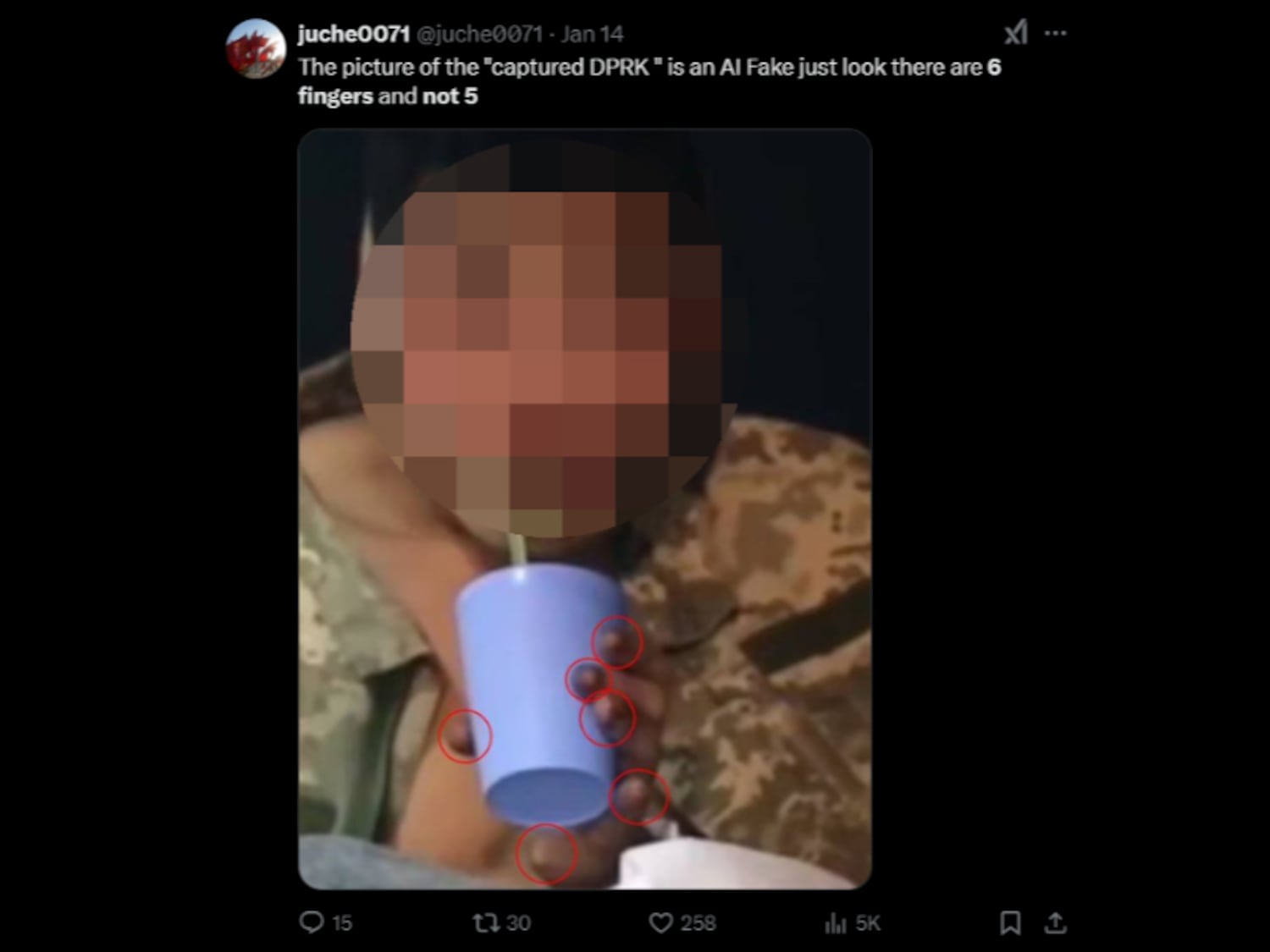
The presence of six fingers would indicate AI manipulation since Artificial Intelligence often struggles to accurately render hands.
Original video
But the accusations appear to be unfounded.
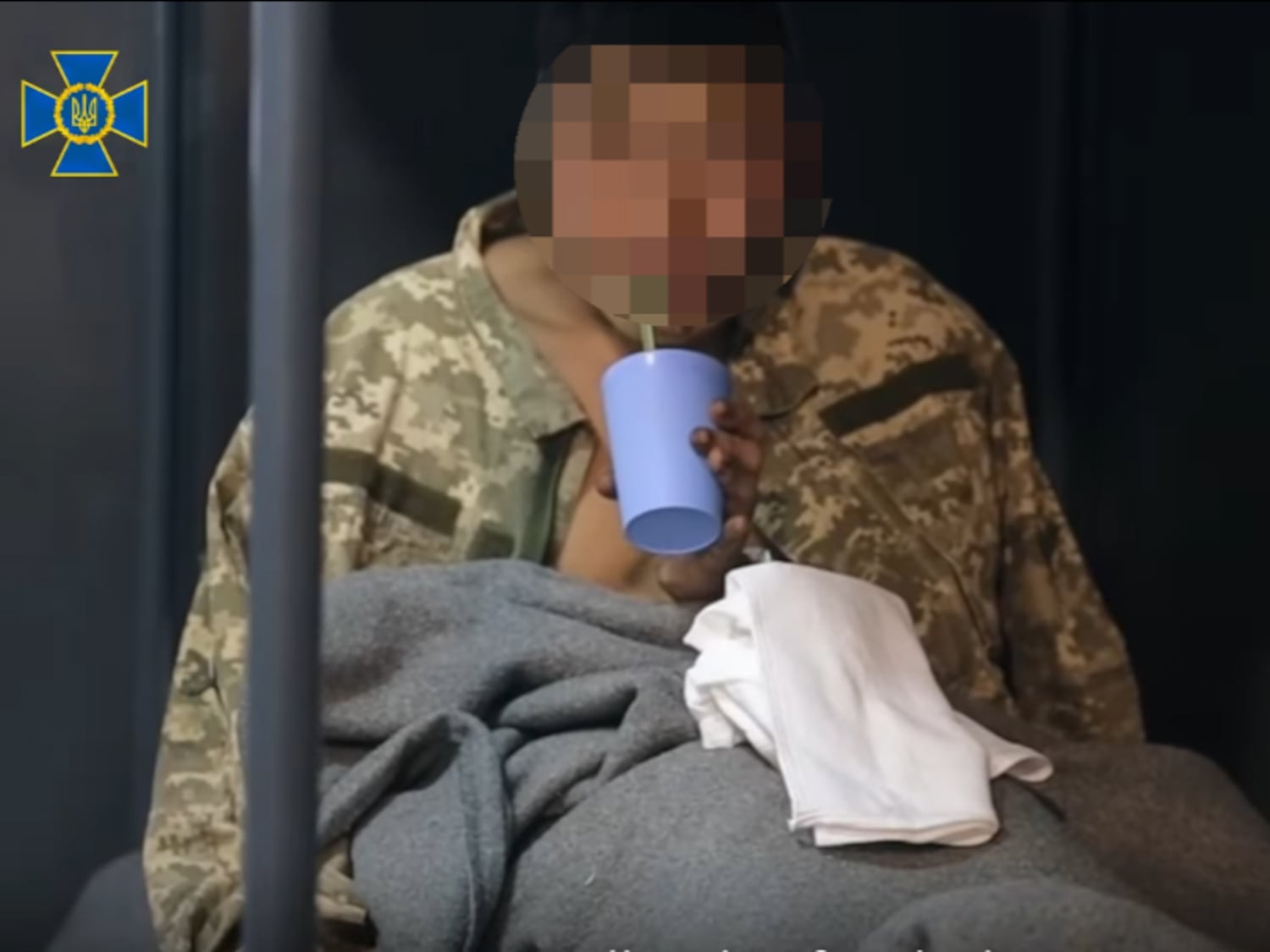
A reverse image search found the photo was taken from a video published by the SSU, on Jan. 11. The man seen in the image posted by X post can be seen at the video’s 35-second mark.
In the video, the man’s left hand can be seen blackened and dirty, and it appears that the white area at the point where the palm and wrist meet seems to have created an optical illusion that a sixth finger exists.
A closer look at other parts of the video, including at the clip’s two-minute and 32-second mark, shows that the man has five fingers on his left hand.

Taiwanese information security expert Paul Liu said the intricate details captured in the video confirmed it was neither AI-generated nor tampered with.
For example, at the video’s 2:36 mark, someone hands a pen to another person. “This is something the AI generation typically struggles with because it involves three overlapping objects: hand A, the pen, and hand B,” Liu said. “Currently, AI doesn’t handle overlaps involving more than two objects very well.”

Liu also pointed to scenes where the video showed details of an identity card.
“AI currently cannot produce something as clear as what’s shown on the passport unless the entire video was post-processed, blending real and fake elements together.”
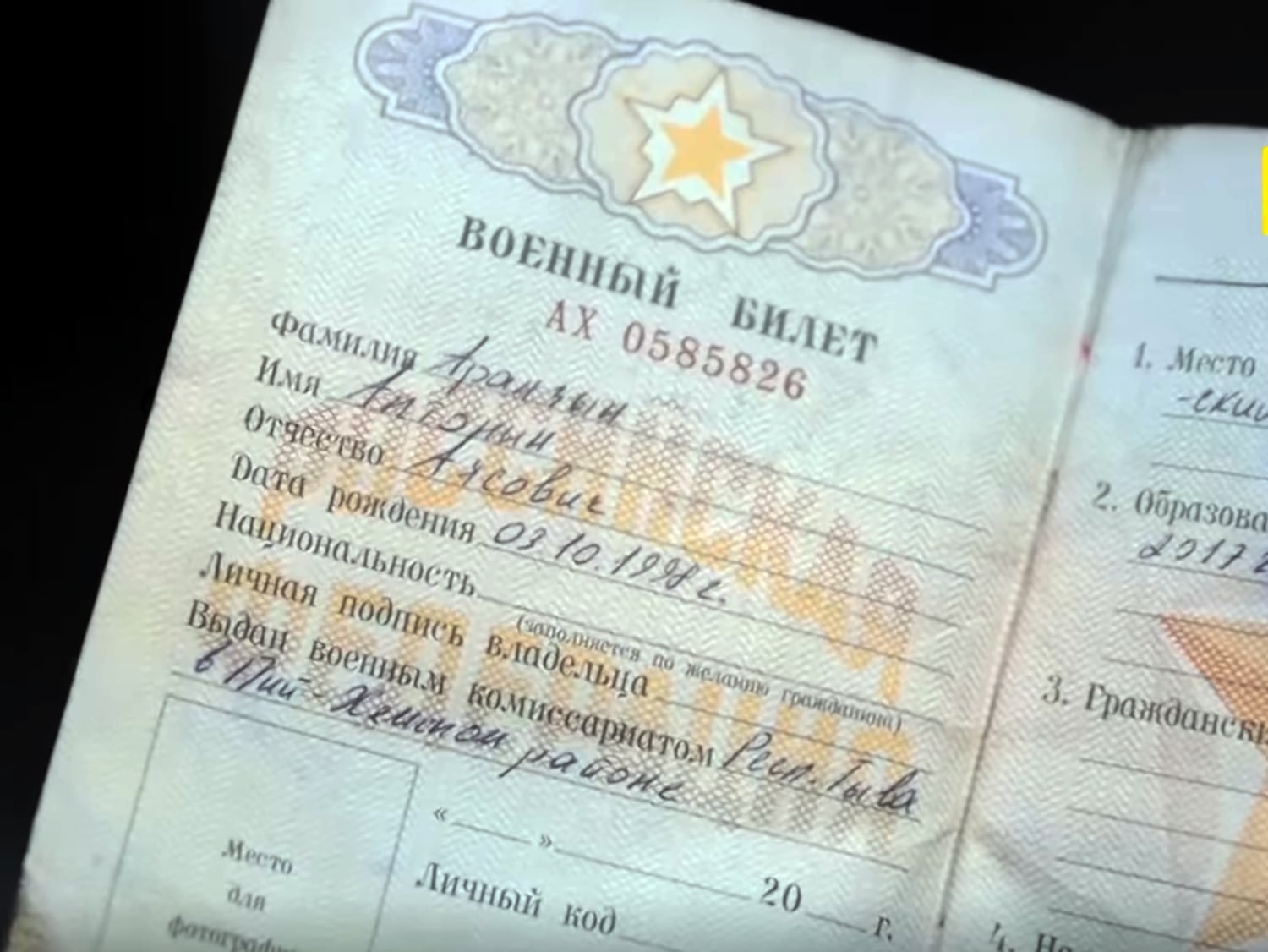
“Comparing the footage from different timestamps, the indentations on the man’s face and the location of the injuries on his hand are consistent,” Liu added.
Yu Chia-Mu, associate professor at Taiwan’s National Yang Ming Chiao Tung University and an AI safety expert, said the man’s little finger did look slightly suspicious at the video’s 35-second mark, but he did not clearly see six fingers.
AI detection tools
The use of tools used to detect AI-generated content found that the video was unlikely to have been manipulated.
Deepware, a tool designed to detect deepfakes and manipulated digital media using advanced AI algorithms, found no deepfake from the video.
A deepfake is a synthetic media creation, often a video or audio, generated using artificial intelligence to imitate a person’s likeness or voice, often with high realism.
A check of the high-definition photos of the man released by Ukraine President Zelenskyy with Sightengine, a tool that analyzes images for potential manipulation, showed the likelihood of manipulation at just 1%, while Hive Moderation, another image analysis tool, assessed it even lower at 0.3%.
Both tools concluded that the photo was original and unaltered.
Meanwhile, the Image Detector, which estimates whether an image was created by a human or generated by AI, found a 74.11% likelihood that the photo was human-taken and a 30.77% likelihood of AI generation, ultimately concluding that the photo was “moderately likely to have been created by a human.”
The Center for Countering Disinformation, a working body of the National Security and Defense Council of Ukraine, dismissed the claim on Jan. 13.
“Propaganda sources circulate claims that either identify the prisoners as Russians from the Republic of Tuva, argue that they are South Koreans rather than North Koreans, or dismiss the video of their interrogation as staged,” the center said on its official X channel.
As of Jan. 15, the center had not responded to Radio Free Asia’s inquiries.
Edited by Taejun Kang and Malcolm Foster.
This content originally appeared on Radio Free Asia and was authored by Jamin Anderson for RFA Korean and Alan Lu for Asia Fact Check Lab.
This post was originally published on Radio Free.
The Shangri-La Dialogue laid bare China’s undeniable support for Russia in the war in Ukraine, as well as Beijing’s blatant hypocrisy when it says it “supports the policy of territorial integrity and sovereignty”. Last October Harvard’s John F. Kennedy School of Government led a series of study groups asking “Is the War in Ukraine Distracting […]
The post The Increasing Impact of Asia in Europe and the Ukraine War appeared first on Asian Military Review.
This post was originally published on Asian Military Review.
Read a version of this story in Korean
The Ukrainian military has recovered combat instructions and personal photos from a North Korean soldier killed in action in Russia’s war with Ukraine, a human rights organization that assisted in translating the documents told Radio Free Asia.
The documents include several directives issued by the North Korean government–but penned by fellow soldiers–on how they should conduct themselves in combat situations like drone attacks, when advancing on enemy positions, and when their comrades are wounded. The photos are believed to show the soldier along with members of his family.
If authentic, the recovered items would represent yet another piece of evidence confirming the presence of North Korean troops in Russia, which Pyongyang and Moscow have not publicly acknowledged. According to estimates from the Pentagon, around 12,000 North Korean soldiers have been deployed to Russia.
Lee Seongmin, the director of the Korea Desk at the New York-based Human Rights Foundation, said in a phone call with RFA Korean on Monday that his organization obtained the documents while assisting Ukrainian Special Forces with translation.
“The documents were written by soldiers on the battlefield and are an important source of information that provides insight into the internal situation of the North Korean military,” said Lee.
One of two photos recovered from the soldier, dated Aug. 14, 2024, shows five people in front of a scenic view of the sea, with text overlay in Korean that says “Making beautiful memories!”
The other photo, dated March 16, 2023, shows a man and a woman, believed to be the soldier’s sister, standing next to each other.
RFA has not independently verified the authenticity of the photos and documents.
One of the documents, entitled “Combat Experience and Lessons of the 94th Brigade,” compels soldiers to remain resolute in their loyalty to the North Korean state.
“If all front-line soldiers are prepared with strong ideology, conviction, and high combat morale, even enemies equipped with modern weaponry can be defeated through political and ideological superiority, as well as tactical advantage,” it said.
Explore more RFA coverage on this topic
Russians ‘burning faces’ of dead North Koreans to keep them secret: Zelenskyy
Russia, North Korea lost ‘up to a battalion’ of soldiers in Kursk: Zelenskyy
It also lionized soldiers from the brigade who died in battle, saying they “maintained a high level of mental and combat spirit,” and were “determined to execute the battle orders of the respected Supreme Commander at the cost of our lives,” referring to North Korean leader Kim Jong Un.
Additionally, it said, they advanced on the enemy “like tigers,” an animal considered to be a national symbol in both Koreas, but only officially in the South.
Soldiers were also advised to understand the exact chain of command so that in the event of casualties to key officers, the battle could continue.
Small-scale operations
The instructions also suggested that the soldiers carry out combat operations in small units of two or three soldiers rather than a large force, to lower the effectiveness of enemy artillery fire and drone attacks.
It also advised on how North Korean combatants made themselves vulnerable in their efforts to assist their wounded comrades “resulting in additional casualties.”
“Over 10 such incidents were reported,” it said.
The document also described the difficulties of overcoming a language barrier with Russian forces that has led to more casualties on the battlefield.
Due to the chaos of combat, evacuation points for the wounded were changed. It took 10 hours to evacuate the wounded to hospitals and some died as a result it said.
The ultimate sacrifice
Another document, entitled “Procedure for Task Implementation,” advised the North Korean soldiers not to assist, but to conceal wounded soldiers and continue with their mission.
“During the battle, the wounded shall be handled independently, concealed as much as possible without aid, and the primary unit shall continue to complete its mission,” it said.
Ukrainian President Volodymyr Zelensky last month released a video claiming that Russia was burning the faces of North Korean soldiers to hide evidence that they were participating in operations against Ukraine.
Lee said that the documents show that the North Korean military is gaining combat experience, but at the high cost of lost lives.
“Most of them are just told to go out and execute the mission regardless death or injury,” he said. “Because of this code of conduct, the soldiers just have to do it. The authorities are forcing sacrifices to achieve their goals.”
Translated by Claire S. Lee. Edited by Eugene Whong.
This content originally appeared on Radio Free Asia and was authored by Park Jaewoo for RFA Korean.
This post was originally published on Radio Free.
Read a version of this story in Korean
The Ukrainian military has recovered combat instructions and personal photos from a North Korean soldier killed in action in Russia’s war with Ukraine, a human rights organization that assisted in translating the documents told Radio Free Asia.
The documents include several directives issued by the North Korean government–but penned by fellow soldiers–on how they should conduct themselves in combat situations like drone attacks, when advancing on enemy positions, and when their comrades are wounded. The photos are believed to show the soldier along with members of his family.
If authentic, the recovered items would represent yet another piece of evidence confirming the presence of North Korean troops in Russia, which Pyongyang and Moscow have not publicly acknowledged. According to estimates from the Pentagon, around 12,000 North Korean soldiers have been deployed to Russia.
Lee Seongmin, the director of the Korea Desk at the New York-based Human Rights Foundation, said in a phone call with RFA Korean on Monday that his organization obtained the documents while assisting Ukrainian Special Forces with translation.
“The documents were written by soldiers on the battlefield and are an important source of information that provides insight into the internal situation of the North Korean military,” said Lee.
One of two photos recovered from the soldier, dated Aug. 14, 2024, shows five people in front of a scenic view of the sea, with text overlay in Korean that says “Making beautiful memories!”
The other photo, dated March 16, 2023, shows a man and a woman, believed to be the soldier’s sister, standing next to each other.
RFA has not independently verified the authenticity of the photos and documents.
One of the documents, entitled “Combat Experience and Lessons of the 94th Brigade,” compels soldiers to remain resolute in their loyalty to the North Korean state.
“If all front-line soldiers are prepared with strong ideology, conviction, and high combat morale, even enemies equipped with modern weaponry can be defeated through political and ideological superiority, as well as tactical advantage,” it said.
Explore more RFA coverage on this topic
Russians ‘burning faces’ of dead North Koreans to keep them secret: Zelenskyy
Russia, North Korea lost ‘up to a battalion’ of soldiers in Kursk: Zelenskyy
It also lionized soldiers from the brigade who died in battle, saying they “maintained a high level of mental and combat spirit,” and were “determined to execute the battle orders of the respected Supreme Commander at the cost of our lives,” referring to North Korean leader Kim Jong Un.
Additionally, it said, they advanced on the enemy “like tigers,” an animal considered to be a national symbol in both Koreas, but only officially in the South.
Soldiers were also advised to understand the exact chain of command so that in the event of casualties to key officers, the battle could continue.
Small-scale operations
The instructions also suggested that the soldiers carry out combat operations in small units of two or three soldiers rather than a large force, to lower the effectiveness of enemy artillery fire and drone attacks.
It also advised on how North Korean combatants made themselves vulnerable in their efforts to assist their wounded comrades “resulting in additional casualties.”
“Over 10 such incidents were reported,” it said.
The document also described the difficulties of overcoming a language barrier with Russian forces that has led to more casualties on the battlefield.
Due to the chaos of combat, evacuation points for the wounded were changed. It took 10 hours to evacuate the wounded to hospitals and some died as a result it said.
The ultimate sacrifice
Another document, entitled “Procedure for Task Implementation,” advised the North Korean soldiers not to assist, but to conceal wounded soldiers and continue with their mission.
“During the battle, the wounded shall be handled independently, concealed as much as possible without aid, and the primary unit shall continue to complete its mission,” it said.
Ukrainian President Volodymyr Zelensky last month released a video claiming that Russia was burning the faces of North Korean soldiers to hide evidence that they were participating in operations against Ukraine.
Lee said that the documents show that the North Korean military is gaining combat experience, but at the high cost of lost lives.
“Most of them are just told to go out and execute the mission regardless death or injury,” he said. “Because of this code of conduct, the soldiers just have to do it. The authorities are forcing sacrifices to achieve their goals.”
Translated by Claire S. Lee. Edited by Eugene Whong.
This content originally appeared on Radio Free Asia and was authored by Park Jaewoo for RFA Korean.
This post was originally published on Radio Free.
This content originally appeared on Radio Free Asia and was authored by Radio Free Asia.
This post was originally published on Radio Free.
This content originally appeared on Radio Free Asia and was authored by Radio Free Asia.
This post was originally published on Radio Free.
This content originally appeared on Radio Free Europe/Radio Liberty and was authored by Radio Free Europe/Radio Liberty.
This post was originally published on Radio Free.
Updated Jan. 12, 2025, 11:08 p.m. ET.
Ukraine is prepared to swap captured North Korean troops for its soldiers being held prisoner by Russia, President Volodymr Zelenskyy said, releasing video of two Koreans who Ukraine said were captured in its war against Russia.
As many as 12,000 North Koreans have been sent to help Russia battle Ukrainian forces in Russia’s Kursk region, according to the U.S. and South Korea although Russia and North Korea have not acknowledged their deployment.
Ukraine on Jan. 4 reported 3,800 casualties among the North Koreans. South Korea’s spy agency on Monday put the figure at 300 dead and 2,700 wounded, the Yonhap news agency said.
“Ukraine is ready to hand over Kim Jong Un’s soldiers to him if he can organize their exchange for our warriors who are being held captive in Russia,” Zelenskyy wrote on social media platform X on Sunday.
He said Russian President Vladimir Putin would not be able to make progress in the Ukraine conflict without help from North Korean leader Kim.
“There should be no doubt left in the world that the Russian army is dependent on military assistance from North Korea,” he said.
Zelenskyy’s X post included video of two men Ukraine said were captured North Korean soldiers. Speaking through an interpreter, one said he was told he was on a training exercise and didn’t know where he was.
“I want to live in Ukraine,” the man said when asked his plans while a second nodded when asked if he wanted to return to North Korea.
Radio Free Asia has been unable to verify the authenticity of the video.
RELATED STORIES
North Koreans kick Russians out of their homes to hide from drones: report
Russia, North Korea lost ‘up to a battalion’ of soldiers in Kursk: Zelenskyy
North Korean soldiers fighting with outdated weapons, Ukrainian sergeant says
Zelenskyy said there would “undoubtedly be more” captured North Koreans and suggested that they could help Ukraine get out information about the war to help end it.
“For those North Korean soldiers who do not wish to return, there may be other options available. In particular, those who express a desire to bring peace closer by spreading the truth about this war in Korean will be given that opportunity,” he said.
“It’s only a matter of time before our troops manage to capture others.”
South Korea’s National Intelligence Service said on Monday Russia has been telling North Korean soldiers in Kursk to kill themselves rather than be captured alive by Ukraine, Yonhap reported.
Edited by Mike Firn.
Updated to include comments from South Korea’s National Intelligence Service.
This content originally appeared on Radio Free Asia and was authored by RFA Staff.
This post was originally published on Radio Free.
This content originally appeared on Radio Free Europe/Radio Liberty and was authored by Radio Free Europe/Radio Liberty.
This post was originally published on Radio Free.
This content originally appeared on Radio Free Europe/Radio Liberty and was authored by Radio Free Europe/Radio Liberty.
This post was originally published on Radio Free.
As land forces demand ever-more connectivity over increasingly larger areas, might UAV-based ‘data mules’ emerge as an efficient complement to tactical trunk communications? Land forces rely on a relatively simple ways of communicating. Take a squad of dismounted infantry. Each soldier will be equipped with a Personal Role Radio (PRR). The PRR will connect squad […]
The post Beast of Burden appeared first on Asian Military Review.
This post was originally published on Asian Military Review.
In 2023 the situation in Ukraine had developed into what looked like a stalemate. But 2024 proved that bigger things had been in the making. In 2024, after taking Avdivka, the Russian forces began to deliberate and steadily move forward.
The introduction of FAB bombs, precision ammunition delivered from airplanes flying outside Ukrainian air defenses, broke the Ukrainian defense fortifications. Russian infantry, covered by ample artillery and with the help drones, infiltrated and overwhelmed Ukrainian lines. An ever increasing shortage of Ukrainian troops helped to increase the tempo of progress.
The post Ukraine On The Verge Of Defeat appeared first on PopularResistance.Org.
This post was originally published on PopularResistance.Org.
This content originally appeared on Radio Free Europe/Radio Liberty and was authored by Radio Free Europe/Radio Liberty.
This post was originally published on Radio Free.
This content originally appeared on Democracy Now! and was authored by Democracy Now!.
This post was originally published on Radio Free.
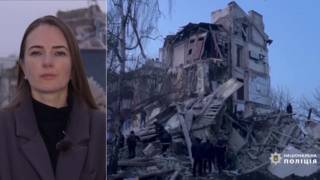
Russian missile and drone attacks are continuing across Ukraine as the country already faces a cold, dark winter after Russia’s strikes destroyed about half of the country’s energy infrastructure. This comes as Russia and Ukraine completed a prisoner swap, repatriating more than 300 prisoners of war in a deal brokered by the United Arab Emirates ahead of the new year. The Biden administration, meanwhile, has approved billions more in military and economic assistance to Ukraine before President-elect Donald Trump returns to office with a pledge to curtail aid and end the war. Since Russia’s invasion nearly three years ago, Congress has approved $175 billion in total assistance to Ukraine. “Putin doesn’t want peace,” says Oleksandra Matviichuk, a leading Ukrainian human rights lawyer, who says Russia’s goal is to restore its empire by force. “Russian occupation means torture, rapes, enforced disappearances, denial of your own identity, forcible adoption of your children, filtration camps and mass graves,” she says.
This content originally appeared on Democracy Now! and was authored by Democracy Now!.
This post was originally published on Radio Free.
A video has been shared in Chinese-language social media posts that claim it shows a state funeral for North Korean general Kim Yong Bok who died while supporting Russia’s war in Ukraine.
But the claim is false. The video shows a funeral of Ri Ul Sol, a close aide of the North Korean founder, who died in 2015 due to illness. The whereabouts of Kim Yong Bok, who was reportedly dispatched to Ukraine to help Russia’s war efforts, is unknown.
The video was shared on X on Dec. 23.
“General Kim Yong Bok, the commander-in-chief of North Korean forces supporting Russia’s invasion of Ukraine, had his body returned to DPRK and received a state funeral from the Grand Marshal [Kim Jong Un],” the caption of the video reads.
The Democratic People’s Republic of Korea, or DPRK, is North Korea’s official name.
In the 30-second video, North Korean leader Kim Jong Un and officials around him can be seen bowing to a convoy of vehicles.
The same video and claim were shared on Douyin, Chinese version of TikTok, as well as on the website of the Taiwanese online media outlet Newtalk News.
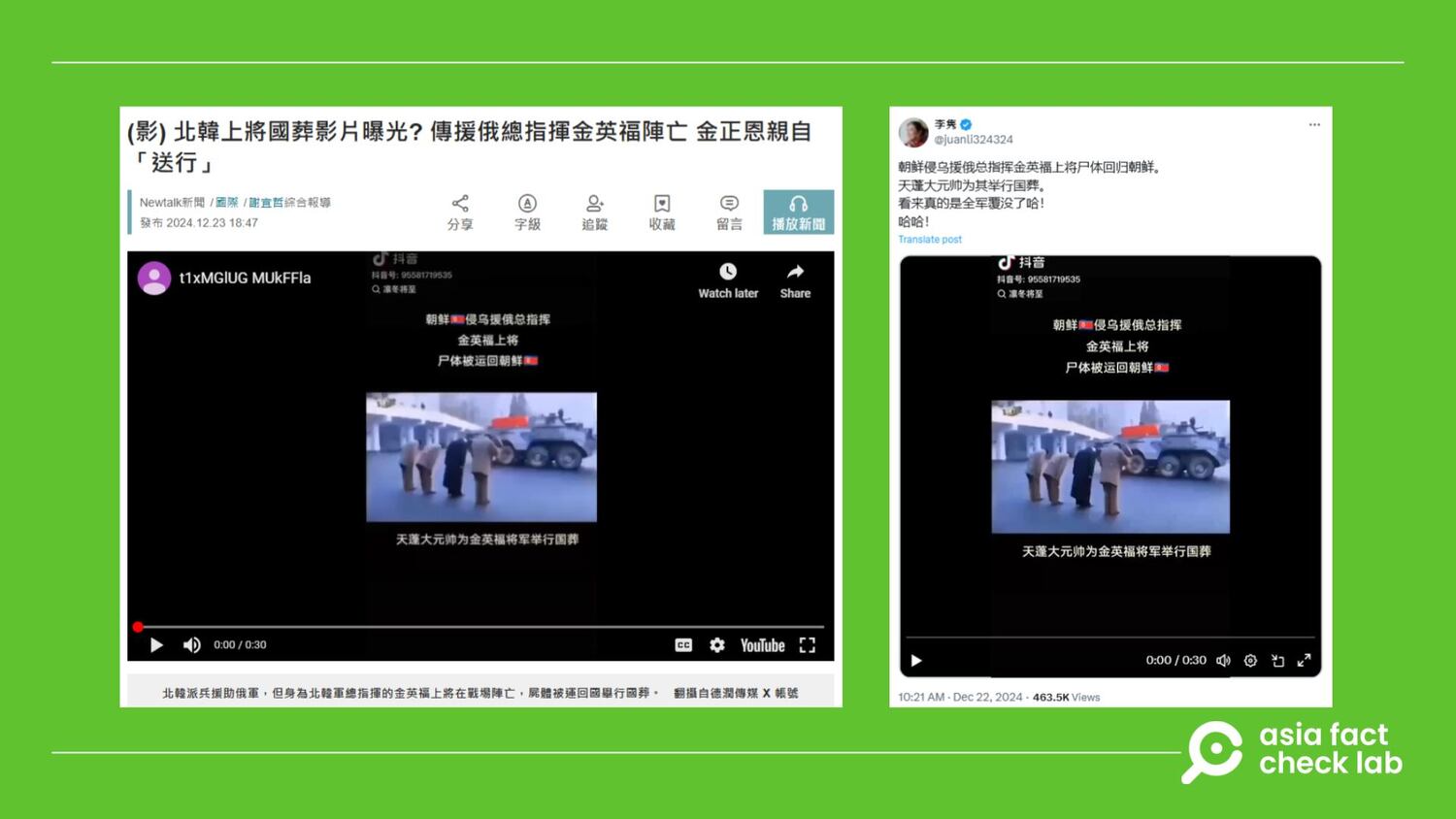
But the claim is false.
Funeral for North Korean founder’s aide
A reverse image search found that the clip shared on social media was taken from a longer YouTube video posted in June 2020.
“Ri Ul Sol, one of North Korea’s first-generation revolutionary founders and marshal of the Korean People’s Army, passed away on November 7, 2015 at age 94 due to an illness. The DPRK held a state funeral for Ri with Kim Jong Un in charge of arrangements,” the caption of the video reads.
A separate search found a report published in 2015 by China’s state-run broadcaster CCTV carrying the same video that shows the funeral of Ri Ul Sol.
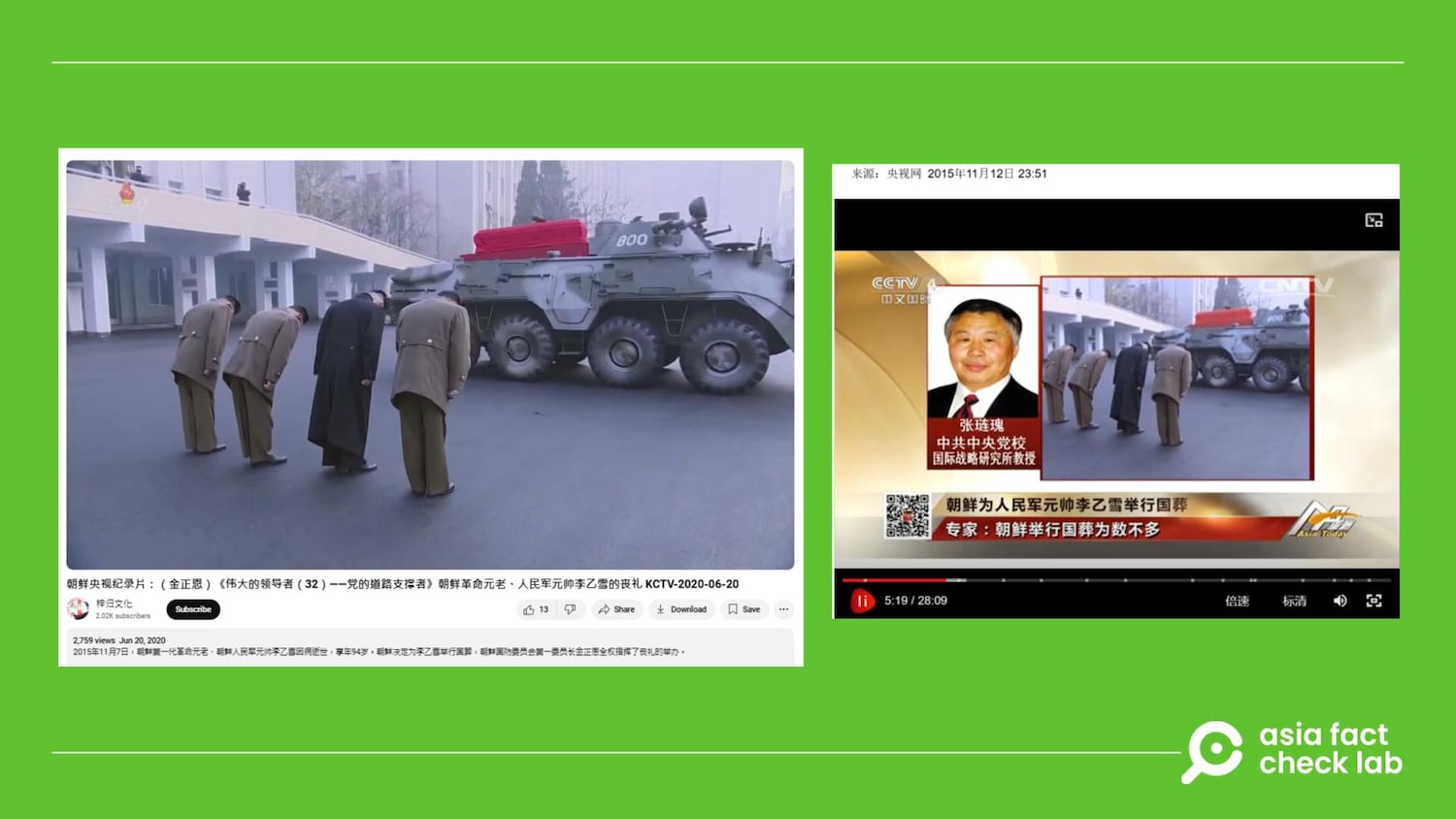
Ri Ul Sol was a North Korean politician and military official, who played an important role in the administrations of North Korean founder Kim Il Sung and former leader Kim Jong Il.
Achieving the rank of marshal of the Korean People’s Army, he was responsible for the safety of top North Korean leaders and their families as Commander of the Guard.
Kim Yong Bok
Japan’s Kyodo News reported in October that Kim Yong Bok, deputy chief of the General Staff of the Korean People’s Army as well as a close aide to leader Kim Jong Un arrived in Russia to oversee North Korean troops there helping Russia in its war against Ukraine.
At that time, Kyodo News said it obtained a list of military officers in charge of the North Korean troops recently sent to Russia, and Kim Yong Bok was at the top.
AFCL has been unable to independently confirm Kim’s recent whereabouts or whether he was killed in combat in Russia.
The Wall Street Journal cited Western officials as saying that a North Korean general was wounded in the Ukraine war in late November, although the general’s identity was not given.
Kim Yong Bok’s profile has risen over the past year. His position as deputy chief of the army was confirmed when he was reported in state media as a member of Kim Jong Un’s entourage during a visit to a key operational training base in western North Korea in March.
Up to 12,000 North Korean soldiers are reportedly in Russia to support its war efforts against Ukraine in Kursk. Ukraine reports over 3,000 casualties among them, while South Korea estimates at least 1,100 have been killed or wounded.
Neither President Vladimir Putin nor North Korean leader Kim Jong Un has confirmed the North’s troop deployment to Russia
Translated by Shen Ke. Edited by Taejun Kang.
Asia Fact Check Lab (AFCL) was established to counter disinformation in today’s complex media environment. We publish fact-checks, media-watches and in-depth reports that aim to sharpen and deepen our readers’ understanding of current affairs and public issues. If you like our content, you can also follow us on Facebook, Instagram and X.
This content originally appeared on Radio Free Asia and was authored by Zhuang Jing for Asia Fact Check Lab.
This content originally appeared on The Grayzone and was authored by The Grayzone.
This content originally appeared on The Grayzone and was authored by The Grayzone.
TAIPEI, Taiwan – Ukraine revealed a handwritten note that is said was found on the body of a North Korean soldier killed in Russia’s Kursk region, as part of its latest evidence highlighting the increasing presence and casualties of North Korean troops in Russia.
American, South Korean and Ukrainian authorities have said there are up to 12,000 North Korean soldiers in Russia, deployed there primarily to help Russia push Ukrainian forces out of positions they captured in Kursk in August.
As of Monday, Ukraine reported that more than 3,000 North Korean soldiers had been killed or wounded in the Russian region, while South Korea estimated the number of casualties among North Korean troops is at least 1,100.
“Dear Song Ji-myong, my closest comrade in arms, celebrating his birthday here on Russian land, away from our beloved Choson and the embrace of his affectionate father and mother,” read the crumpled letter, written in black ballpoint pen. North Koreans refer to their country as Choson.
“I sincerely wish you good health and a happy birthday.”
According to the Ukrainian military, the name written on the soldier’s identification card was Jong Kyong-hong. It is believed that the letter was either not delivered or was a draft, as it was dated Dec. 9.
Ukraine’s Special Operations Forces released a photograph of the note, which was written in Korean, on Tuesday.
“These are some of the deciphered entries from seized notebooks … translations of other entries are in progress and more will be revealed,” said the Ukrainian military.
Radio Free Asia has not been able to independently verify the photo.
Separately, a Ukrainian military intelligence official said the presence of North Korean soldiers alongside Russian troops in Kursk had not yet had a major influence on the course of the battle.
“The involvement of the North Koreans in the fighting has not had a significant impact on the situation. It is not such a significant number of personnel,” Yevgen Yerin, spokesperson for the Ukrainian military intelligence service, told AFP.
“But they are also learning. And we cannot underestimate the enemy. And we can see that they are already taking some things into account in their activities,” he added.
RELATED STORIES
More than 3,000 North Koreans killed, wounded in Russia’s Kursk: Zelenskyy
Ukraine military drops leaflets urging North Korean troops to surrender
Russians see North Koreans as a ‘burden’ over ignorance of drones: South says
Yerin’s remarks came about a week after South Korea’s spy agency said that North Korean soldiers’ inexperience in modern warfare was leading to mass casualties.
“North Korean troops are being ‘consumed’ for front-line assaults in an unfamiliar battlefield environment of open fields, and they lack the ability to respond to drone attacks,” said the South’s National Intelligence Service.
Russian troops were complaining about the North Koreans’ ignorance of drones, calling them a “burden,” the agency added, without elaborating.
Neither President Vladimir Putin nor North Korean leader Kim Jong Un has confirmed the North’s troop deployment to Russia but reports indicate that ties between two countries are progressing swiftly.
The South’s spy agency said last week that North Korea’s military was likely preparing to deploy additional troops and military equipment to Russia, potentially including so-called suicide drones, in support of Moscow’s war against Ukraine.
On Monday, Kremlin foreign policy adviser Yuri Ushakov said that he thought it was likely North Korean troops would participate in Russia’s Red Square parade next year.
Edited by Mike Firn.
This content originally appeared on Radio Free Asia and was authored by Taejun Kang for RFA.
This post was originally published on Radio Free.
Russian prisoners of war captured by Ukrainian forces complained about the lack of discipline and professionalism of North Korean troops dispatched to fight in the conflict, video footage of their interrogation shows.
The videos, published by media outlet RBC-Ukraine shows two Russian soldiers explaining how the North Koreans were “reckless.”
One of the soldiers explained how the North Koreans opened fire on approaching Russians, and how they even shot at other North Koreans.
“They say that they’re headless, that they don’t care where to go and how they go,” he said. “Insane guys.”
The other soldier said that North Koreans fire indiscriminately at any and all drones.
“To be honest, the farther away from the Koreans, the calmer it is…,” he said. “They shoot at … anything that flies. It doesn’t matter if it’s a Russian or Ukrainian (drone).”
The soldiers also said that North Korean troops are better equipped than they were, with the first saying that they had newer weapons and they were better fed than their Russian counterparts.
“I know they eat well,” he said. “If they eat raw smoked sausage, the most delicious thing we ate in the dining room was buckwheat porridge.”
The video footage of the two prisoners, if legitimate, would be yet another example of evidence that North Korea is helping Russia in its war in Ukraine, which Pyongyang and Moscow have not outwardly confirmed.
This content originally appeared on Radio Free Asia and was authored by Eugene Whong for RFA.
This post was originally published on Radio Free.